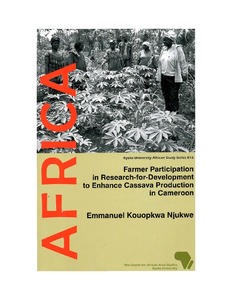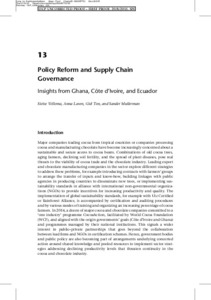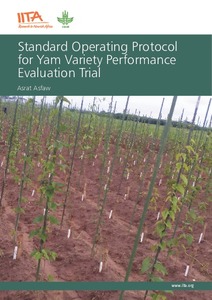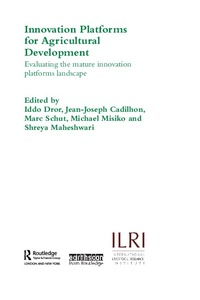Welcome to the International Institute of Tropical Agriculture Research Repository
Books and Book Chapters: Recent submissions
Now showing items 441-460 of 977
-
Regional impact of climate change: Africa
(John Wiley & Sons, 2011) -
Hybrid distribution to farmers adoption and challenges
(Taylor and Francis, 2011-01) -
Integrated systems research in nutrition-sensitive landscapes: A theoretical methodological framework
(Routledge, 2017)Sustainable intensification has recently been developed and adopted as a key concept and driver for research and policy in sustainable agriculture. It includes ecological, economic and social dimensions, where food and nutrition security, gender and equity are crucial components. This book describes different aspects of systems research in agriculture in its broadest sense, where the focus is moved from farming systems to livelihoods systems. -
Challenges and opportunities for macropropagation technology for Musa spp. among smallholder farmers and small-and medium-scale enterprises
(Centre for Agriculture and Biosciences International, 2013)Lack or shortage of healthy and improved planting material is a major constraint to the expansion of banana and plantain production. The situation is made worse by the lack of formal systems for producing and distributing quality planting material, thereby forcing farmers to depend on natural regeneration of plants for their supply. This is usually a very slow process, and produces small amounts of planting material that are likely to be contaminated with soil-borne pathogens such as nematodes. ... -
Intensive cereal-legume–livestock systems in West African dry Savannas.
(International Center for Tropical Agriculture, 2012)The dry savannas of West Africa are undergoing rapid transformation of agricultural practices owing to the rapid human and livestock population growth, increase in agricultural intensification and accelerated climate change which has increased the incidence and severity of diseases, pests and drought. The major constraints to agricultural production in the savanna include poor soil fertility, pests and diseases of crops and livestock, parasitic weeds such as Striga hermonthica, drought, and ... -
Slash-and-burn agriculture, effects of
(Elsevier, 2013-03-07) -
Crop–livestock–tree integration in Uganda: the case of Mukono–Wakiso innovation platform
(Earthscan, Routledge, 2016) -
Adapting a yam seed technique to meet farmers’ criteria
(2016)Seed yam is costly, and can carry pests and diseases. To reduce costs and to manage seed health, in the 1970s, the Yam Minisett Technique (YMT) was developed, which involved cutting yams into small pieces to be used as seed. Few farmers adopted the technique, in part because of the high labor requirements of making a nursery to sprout the pieces of tuber. In 1992, a DFID-funded project introduced fungicide and insecticide treatment to improve the survival of yam minisetts. The Adapted Yam Minisett ... -
The sustainability of the world’s soils
(2016)Agriculture and food production are predominantly soil-based, with only marginal portions based on hydroponics or the use of only biomass as a substrate. In this chapter, the factors aff ecting sustainable soil use will be elaborated. This is defi ned as factors that: • maintain or improve soil biological, chemical, and physical properties; • maintain an input:output (harvest) ratio greater than one for all macronutrients; • use nutrient inputs, preferably but not exclusively from renewable rather ... -
The sawflies of Namibia and western South Africa (Symphyta, Hymenoptera).
(Belgian National Focal Point, 2015-10-15)This monograph includes a history of the study of the sawflies of the Afrotropical Region; recommended collecting methods; a general description of the life cycle of sawflies; and extensive references to Afrotropical sawflies. A total of 55 species of Symphyta have been reported from the study area, which comprises Namibia and the western parts of South Africa. Previously, 26 species were known from Namibia and 29 species, including four introduced species, from the South African part of this ... -
Farmer participation in Research-for-Development to enhance cassava production in Cameroon
(Shoukadoh Book Sellers, 2016)Cassava (Manihot esculenta Crantz) is a staple food crop in Cameroon and cultivated mainly for its starchy roots consumed raw, boiled or processed, but also for its leaves which serve as vegetable. Despite its importance, the yield gap is often large due to many challenges that include low soil fertility and the use of traditional production techniques while local varieties are susceptible to pests and diseases. To overcome these challenges, there have been efforts to introduce and evaluate several ... -
Cowpea
(Springer, 2015-08-28)Cowpea, Vigna unguiculata, is an important grain legume adapted to the sub-Saharan Africa (SSA) where it contributes to the nutrition, health, and income of rural and suburban inhabitants. It is indigenous to SSA with both cultivated and wild relatives distributed across the whole subregion. The International Institute of Tropical Agriculture (IITA) holds a collection of more than 15,000 accessions from 90 countries. This valuable source of traits is being exploited to address preferences of ... -
Policy reform and supply chain governance: Insights from Ghana, Cote d'Ivoire, and Ecuador
(Oxford University Press, 2016-03) -
Aluminium stress in crop plants
(Astral International Pvt. Ltd., 2016)Aluminium (Al) toxicity has a strong negative impact on crop productivity on acid mineral soils. Liming and fertilisation frequently are insufficient to overcome the problem, especially in tropical areas with subsoil acidity. The focus on breeding for acid soil tolerance as a more sustainable tool to achieve better crop performance has strongly stimulated research into the mechanisms of Al toxicity and tolerance. Root tips have been identified as the primary target of Al toxicity in most crops, ...







